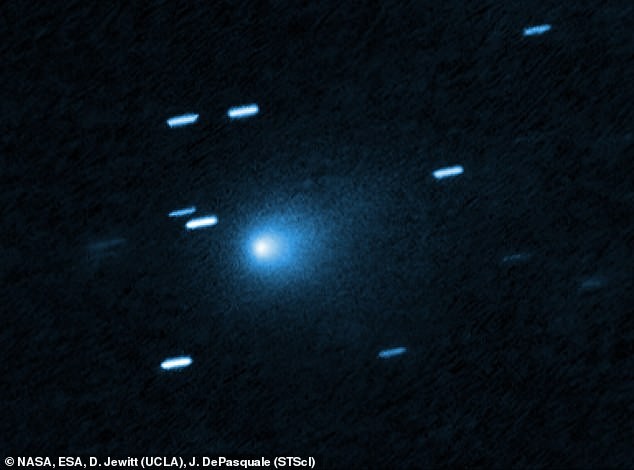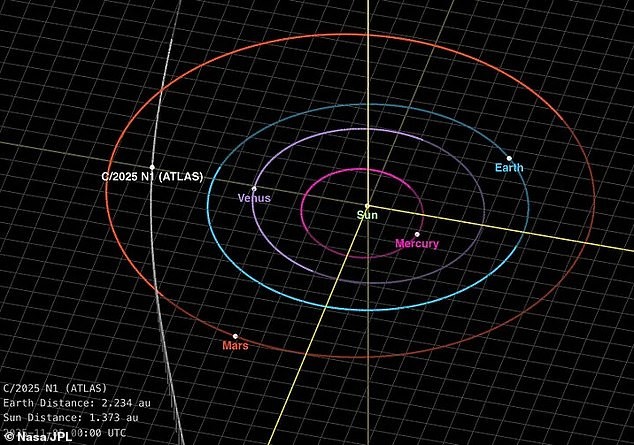Interstellar visitor speeds up on its way to Earth and NASA asks: is there alien propulsion at work
An interstellar object racing through our solar system has been caught unexpectedly picking up speed as it moves away from the sun and closer toward Earth. NASA has confirmed a small extra 'kick' moving the mysterious visitor dubbed 3I/ATLAS off its predicted path, which can't be explained by the sun's gravity. The sun contains almost all of the solar system’s mass, meaning its weight pulls all the planets together in a predictable motion scientists can measure, but these new movements by 3I/ATLAS appear to defy our laws of gravity.

In This Article:
- 3I/ATLAS sets record as the fastest space rock entering the solar system
- Perihelion: speed spikes after closest approach to the Sun
- Non-gravitational acceleration and the comet evaporation question
- Color changes, anomalies and the extraterrestrial engines hypothesis
- Composition, mass and the alien mothership theory
- Looking ahead: Webb telescope and the search for an alien engine
3I/ATLAS sets record as the fastest space rock entering the solar system
3I/ATLAS set a record as the fastest space rock entering the solar system ever detected by humans at more than approximately 209,000 km/h. The object, which many scientists claim is a comet, set a record as the fastest space rock entering the solar system ever detected by humans at more than approximately 209,000 km/h.

Perihelion: speed spikes after closest approach to the Sun
After reaching its closest point to the sun on October 29, known as perihelion, its speed has now soared to approximately 245,000 km/h. While NASA believes the sun's gravity is mainly responsible for the speed boost, scientists are having a harder time figuring out what has caused 3I/ATLAS to noticeably shift away from our home star.

Non-gravitational acceleration and the comet evaporation question
3I/ATLAS (pictured) has exhibited unique features, including an anti-tail, extreme color changes, and an extremely unusual course through our solar system. Harvard physicist Avi Loeb has revealed that astronomers are still awaiting evidence that 3I/ATLAS has released anywhere close to enough gas to prove the object is really a comet. "If 3I/ATLAS is not enshrouded in a much more massive gas cloud after perihelion than it had in the months preceding perihelion, then its recent non-gravitational acceleration must have resulted from a different cause than cometary evaporation," Loeb said on Wednesday.

Color changes, anomalies and the extraterrestrial engines hypothesis
The supposed comet, 3I/ATLAS, mysteriously turned blue as it approached the sun on October 29, unlike normal comets which turn red. Loeb added that there are now 10 strange anomalies that science can't completely explain when it comes to the interstellar visitor's trip through the solar system. 3I/ATLAS neared our sun and 3I/ATLAS has shown that not detecting a cloud of gas coming from the object would be a clear sign that this latest speed boost was powered by an extraterrestrial rocket engine. It’s also incredibly massive, weighing approximately 33 billion tonnes, which Loeb said doesn't make sense because there isn't enough rocky material in interstellar space to have created such a structure naturally.

Composition, mass and the alien mothership theory
Unlike the supposed comet in our solar system, which are mainly composed of ice and water, scans have shown that 3I/ATLAS is an odd mixture of nickel and carbon dioxide. Loeb has theorized that 3I/ATLAS could be a nuclear-powered 'mothership,' which would explain how it could get unusually bright if it were generating its own light. Also, its nickel shell, which originally turned the object green, could be a sign of an alien intelligence using the valuable metal as a protective coating against the extreme heat of approaching our sun, just like humans do with manmade space probes.

Looking ahead: Webb telescope and the search for an alien engine
In December, the James Webb Space Telescope will look for this giant cloud around 3I/ATLAS. Avi Loeb noted that 3I/ATLAS showed little evidence of shedding enough of its mass as it got closer to the sun last month. Is the interstellar visitor of extraterrestrial origin? NASA's latest readings found the mystery push got significantly weaker in the days after 3I/ATLAS reached its perihelion with the sun, but it was still noticeable and unrelated to the star's gravitational pull. For a natural space rock to pull off this strange maneuver, scientists examining the NASA data have estimated that 3I/ATLAS would have had to suddenly lose at least 13 percent of its total mass as it approached the sun. That's the only way enough of the comet would have been transformed into a gas that blasted the object away like a thruster on a spacecraft. If this happened while 3I/ATLAS was hiding in the sun's blind spot from our viewpoint on Earth, a huge cloud of dust and gas from that event would have formed around the rock. The James Webb Space Telescope will look for this giant cloud around 3I/ATLAS in December. Loeb added that there are now 10 strange anomalies that science can't completely explain when it comes to the interstellar visitor's trip through the solar system.

